Human settlement in South Africa
Modern humans have been inhabiting South Africa for more than 100 000 years. As a matter of fact, the Cradle of Humankind, or what is believed to be the birthplace of humans, is close to Pretoria in Gauteng, and is the source of the oldest hominid discovery in the world to date.
Some of the earliest people to arrive in what we know as South Africa from further north in Africa were the San and Khoikhoi. The San are also known as Bushmen and the Khoikhoi as Hottentots, but these names are not used anymore. As a group they are often called the Khoisan. These two groups of people had different lifestyles and arrived here thousands of years before the first European people.
The Khoisan were not the only early residents of our area. Bantu-speaking people also arrived here hundreds of years before any Europeans as can be seen in the ruins of the cities of Thulamela, Mapungubwe and Great Zimbabwe. All three these kingdoms were active gold miners, farmers and traders before the arrival of the Portuguese, the first Europeans to set foot in southern Africa in the late 1400s.
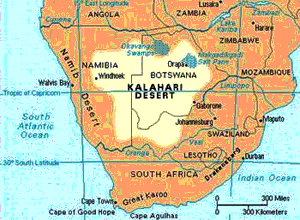 The Kalahari Desert stretches through Namibia and Botswana and, even though it is an extremely harsh environment, is still home to some San communities, like the !Kung, who live in Nyae Nyae. Source: www.opendemocracy.net
The Kalahari Desert stretches through Namibia and Botswana and, even though it is an extremely harsh environment, is still home to some San communities, like the !Kung, who live in Nyae Nyae. Source: www.opendemocracy.net
Hunter-gatherersWhat is hunting and gathering?
Hunter-gatherer societies are made up of nomadic groups of people that hunt, fish and gather wild food to survive.
Hunter-gatherers in southern Africa
Hunting and gathering was the way of life for most people on the planet for the largest part of the last 100 000 years. During this century communities of hunter-gatherers could still be found in Southern Africa, but their way of life has changed a great deal over the past 50 years.
An example of this kind of society are the !Kung people. They were part of several thousand San people who were still hunting game with their traditional poisoned arrows and gathering plants in the Kalahari Desert in Namibia. The !Kung lived in an area called Nyae Nyae. Near the border between Botswana and Namibia.
The KhoikhoiWhat is a pastoral society?
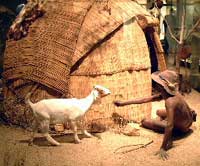 The Khoikhoi kept animals but still migrated when their grazing was exhausted and still hunted for food. Source: www.capetown.at
The Khoikhoi kept animals but still migrated when their grazing was exhausted and still hunted for food. Source: www.capetown.at
In a pastoral society animals are domesticated and raised for food. These societies are generally nomadic. They raise animals because they live in areas that are too dry to farm with crops and move on to a new home when their herds have finished all the available food in an area.
Pastoralists in southern Africa
The Khoikhoi were animal herders and lived in a pastoral society. They arrived in the western part of southern Africa about 2 000 years ago about 100 years BC. Their lifestyle was very different from the San, who were hunter-gatherers, and they brought a new way of life and new skills to this part of the African continent.
Even though they were often called Hottentots the Khoikhoi people always knew themselves by their own name, Khoikhoi, which means “men of men” or “ the real people”. They were proud of their ancestry. They became the “Hottentots” because the sound of their language was so different from any European language and because the colonisers could not pronounce many of the words and sounds. They used a word while dancing that sounded like Hottentots and that became their name. This term is considered insulting today.
The Khoikhoi and San in conflict
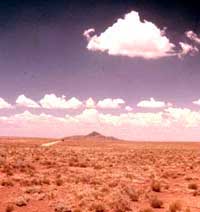 The land used by the Khoikhoi and San became overgrazed as a result of the Khoikhoi's herds of domesticated animals. This drove the San's game away and caused serious conflict between the two groups. Source: www.cpluhna.nau.edu
The land used by the Khoikhoi and San became overgrazed as a result of the Khoikhoi's herds of domesticated animals. This drove the San's game away and caused serious conflict between the two groups. Source: www.cpluhna.nau.edu
The Khoikhoi and San lifestyles were different, and they competed for scarce resources. The main reason for conflict was the limited amount of game available. The Khoikhoi were animal herders, but they still hunted for food and mostly used their cattle as food for important events. The domesticated animals also began using up too much of the grass, driving out wild animals. This caused the San to go hungry and they began killing the Khoikhoi's sheep and cattle for food. This situation resulted in a war that lasted for hundreds of years.
The fighting and other contact between the two groups had serious effects on both. The Khoikhoi gathered in larger groups to protect themselves against the San. Some of the San made peace with their enemies and joined their society; some kept on fighting and moved to the mountains and deserts, while others formed groups of robbers that raided Khoikhoi herds.
African farmers in southern AfricaWhat is farming?
Farming means raising animals or crops for food and other necessities. It was a very important change when people stopped relying on hunting and gathering for food and began farming. This agricultural revolution happened all over the world about 10 000 year ago and for the first time animals and plants were domesticated. It also changed the way society operated as people began living in larger groups because of the availability of food. Towns and cities developed and people had to learn the skills of living in a larger group, like trading extra food, building roads to travel on, finding different ways to transport things and ways of communicating between groups.
Farming in southern Africa
African farmers arrived in southern Africa around 250 AD from further north. They were Bantu-speaking people and lived in an era that archaeologists call the Iron Age.
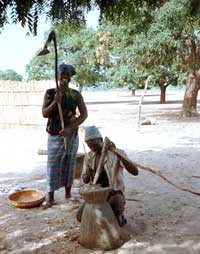 The hoe (seen above) is still an important agricultural tool, but it was replaced with the plough in many communities. Sources: web.nwe.ufl.edu
The hoe (seen above) is still an important agricultural tool, but it was replaced with the plough in many communities. Sources: web.nwe.ufl.edu
These farmers brought new influences to southern Africa, just like the Khoikhoi and their herds of animals. They introduced the raising of crops, metal tools, Bantu languages and village life to the eastern part of our country. They decided to live here because it is a summer rainfall area that is good for growing crops. For a long time many people believed that African farmers arrived in South Africa at the same time as European settlers, but new research proves that they were here hundreds of years before the Europeans.
Crops and cattle
Crop farming was a new way of living in southern Africa and all the growers were subsistence farmers. That means that every family only planted and harvested what they needed for themselves. The men in the group still hunted for food, and also herded cattle, goats and sheep, as well as planting crops.
Cattle were very important, but everyday survival depended on crops, which were the responsibility of the women in the group. Men helped to do heavier work, like clearing the ground, but the wooden and later iron hoe made their work much easier. The arrival of the ox-plough with European settlers changed the role of women in some communities completely because it replaced the hoe. They were no longer needed for women to cultivate the land as oxen were used to plough the land and women weren't allowed to rear cattle. Men took over the role and so women's position was weakened.
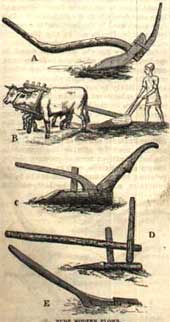 The ox-plough not only changed farming techniques, but also the role of women in communities. Source: www.ls.net
The ox-plough not only changed farming techniques, but also the role of women in communities. Source: www.ls.net
The plough also made larger scale farming possible, which would require more land. Although the land belonged to the community some members had the right to plant and harvest crops to feed the group. Some farms were larger than others, but everyone had a right to land.
African farmers had much larger herds of cattle than Khoikhoi farmers. Cattle were a sign of power and wealth and were so valuable because they provided milk and meat, skin for clothes, and horns for containers. Their droppings were used as fuel for fires and for plastering walls and floors, and they were used as a form of money to pay fines or for a bride, a tradition that is called “lobola” or “bogadi”.These communities did live in large settlements, but still migrated whenever the soil and grazing had been used up.
To find out more about the origins, languages and cultures of the people of South Africa visit our 'People of South Africa' feature.